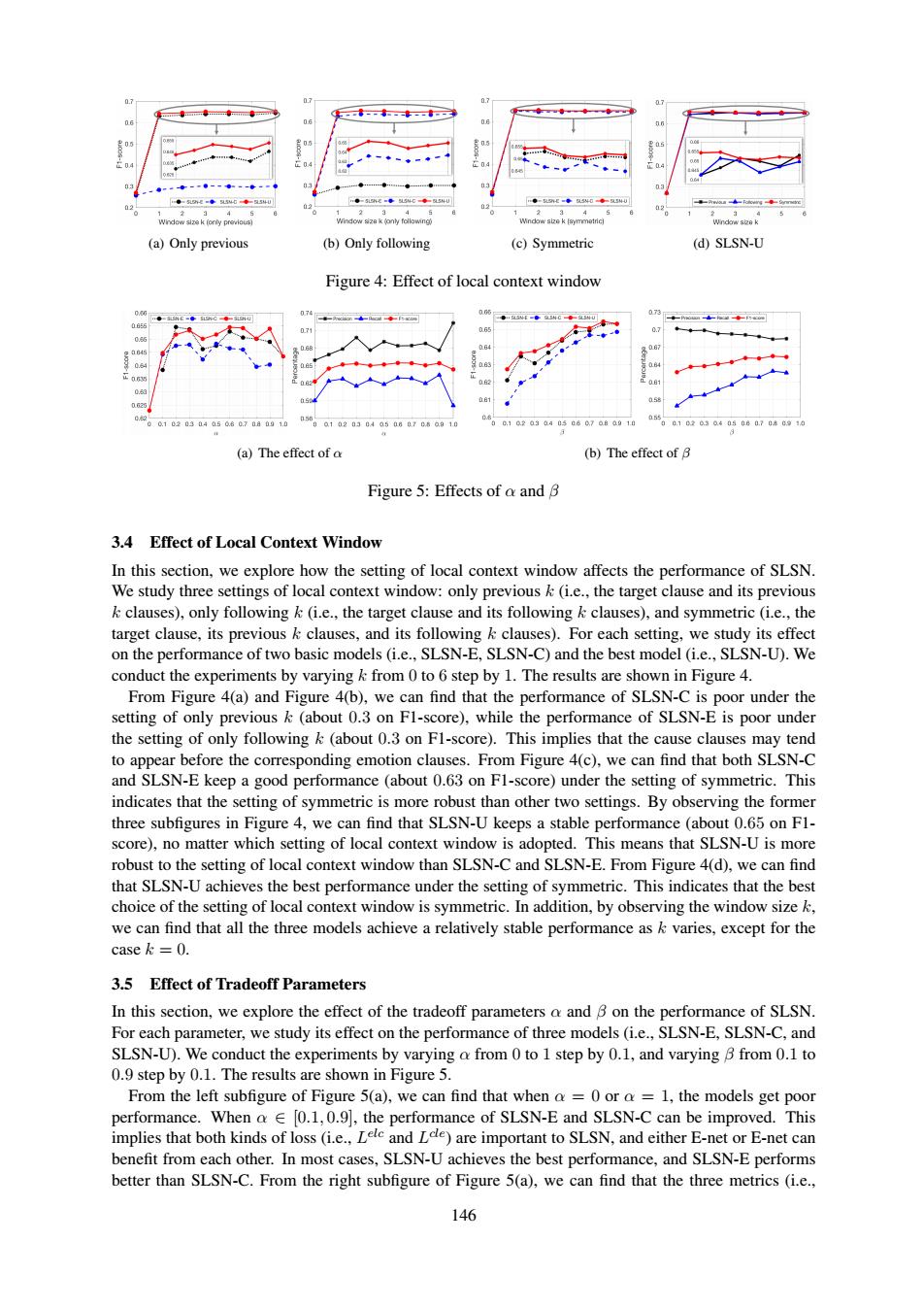正在加载图片...

06 0 04 ◆-52-◆6◆双54U ●-5乳he■●540◆队54y ●=5E=◆540◆5U 5 (a)Only previous (b)Only following (c)Symmetric (d)SLSN-U Figure 4:Effect of local context window 07 0G6 073 n65 0.8 5 203a4a5080.7a9 1a1a2004a5a80.70a910 10 0,1026304050807040910 (a)The effect of o (b)The effect of B Figure 5:Effects of a and B 3.4 Effect of Local Context Window In this section,we explore how the setting of local context window affects the performance of SLSN. We study three settings of local context window:only previous k(i.e.,the target clause and its previous k clauses),only following k(i.e.,the target clause and its following k clauses),and symmetric (i.e.,the target clause,its previous k clauses,and its following k clauses).For each setting,we study its effect on the performance of two basic models (i.e.,SLSN-E,SLSN-C)and the best model (i.e.,SLSN-U).We conduct the experiments by varying k:from 0 to 6 step by 1.The results are shown in Figure 4. From Figure 4(a)and Figure 4(b),we can find that the performance of SLSN-C is poor under the setting of only previous k(about 0.3 on F1-score),while the performance of SLSN-E is poor under the setting of only following k(about 0.3 on F1-score).This implies that the cause clauses may tend to appear before the corresponding emotion clauses.From Figure 4(c),we can find that both SLSN-C and SLSN-E keep a good performance (about 0.63 on F1-score)under the setting of symmetric.This indicates that the setting of symmetric is more robust than other two settings.By observing the former three subfigures in Figure 4,we can find that SLSN-U keeps a stable performance (about 0.65 on F1- score),no matter which setting of local context window is adopted.This means that SLSN-U is more robust to the setting of local context window than SLSN-C and SLSN-E.From Figure 4(d),we can find that SLSN-U achieves the best performance under the setting of symmetric.This indicates that the best choice of the setting of local context window is symmetric.In addition,by observing the window size k, we can find that all the three models achieve a relatively stable performance ask varies,except for the casek =0. 3.5 Effect of Tradeoff Parameters In this section,we explore the effect of the tradeoff parameters a and B on the performance of SLSN For each parameter,we study its effect on the performance of three models(i.e.,SLSN-E,SLSN-C,and SLSN-U).We conduct the experiments by varying a from 0 to 1 step by 0.1,and varying B from 0.1 to 0.9 step by 0.1.The results are shown in Figure 5. From the left subfigure of Figure 5(a),we can find that when a =0 or a =1,the models get poor performance.When a E [0.1,0.9],the performance of SLSN-E and SLSN-C can be improved.This implies that both kinds of loss(i.e.,Lele and Lde)are important to SLSN,and either E-net or E-net can benefit from each other.In most cases,SLSN-U achieves the best performance,and SLSN-E performs better than SLSN-C.From the right subfigure of Figure 5(a),we can find that the three metrics(i.e., 146146 (a) Only previous (b) Only following (c) Symmetric (d) SLSN-U Figure 4: Effect of local context window (a) The effect of α (b) The effect of β Figure 5: Effects of α and β 3.4 Effect of Local Context Window In this section, we explore how the setting of local context window affects the performance of SLSN. We study three settings of local context window: only previous k (i.e., the target clause and its previous k clauses), only following k (i.e., the target clause and its following k clauses), and symmetric (i.e., the target clause, its previous k clauses, and its following k clauses). For each setting, we study its effect on the performance of two basic models (i.e., SLSN-E, SLSN-C) and the best model (i.e., SLSN-U). We conduct the experiments by varying k from 0 to 6 step by 1. The results are shown in Figure 4. From Figure 4(a) and Figure 4(b), we can find that the performance of SLSN-C is poor under the setting of only previous k (about 0.3 on F1-score), while the performance of SLSN-E is poor under the setting of only following k (about 0.3 on F1-score). This implies that the cause clauses may tend to appear before the corresponding emotion clauses. From Figure 4(c), we can find that both SLSN-C and SLSN-E keep a good performance (about 0.63 on F1-score) under the setting of symmetric. This indicates that the setting of symmetric is more robust than other two settings. By observing the former three subfigures in Figure 4, we can find that SLSN-U keeps a stable performance (about 0.65 on F1- score), no matter which setting of local context window is adopted. This means that SLSN-U is more robust to the setting of local context window than SLSN-C and SLSN-E. From Figure 4(d), we can find that SLSN-U achieves the best performance under the setting of symmetric. This indicates that the best choice of the setting of local context window is symmetric. In addition, by observing the window size k, we can find that all the three models achieve a relatively stable performance as k varies, except for the case k = 0. 3.5 Effect of Tradeoff Parameters In this section, we explore the effect of the tradeoff parameters α and β on the performance of SLSN. For each parameter, we study its effect on the performance of three models (i.e., SLSN-E, SLSN-C, and SLSN-U). We conduct the experiments by varying α from 0 to 1 step by 0.1, and varying β from 0.1 to 0.9 step by 0.1. The results are shown in Figure 5. From the left subfigure of Figure 5(a), we can find that when α = 0 or α = 1, the models get poor performance. When α ∈ [0.1, 0.9], the performance of SLSN-E and SLSN-C can be improved. This implies that both kinds of loss (i.e., L elc and L cle) are important to SLSN, and either E-net or E-net can benefit from each other. In most cases, SLSN-U achieves the best performance, and SLSN-E performs better than SLSN-C. From the right subfigure of Figure 5(a), we can find that the three metrics (i.e